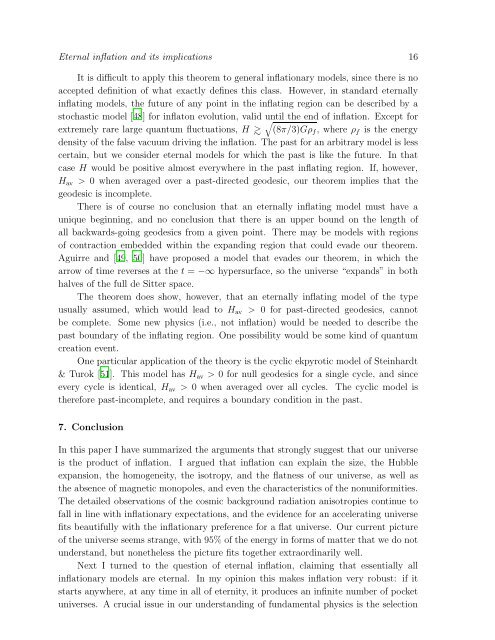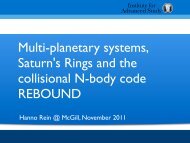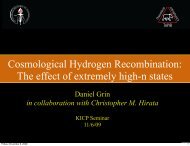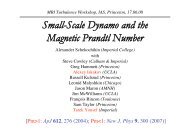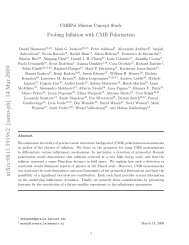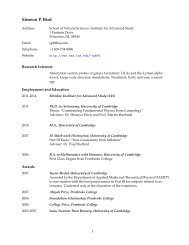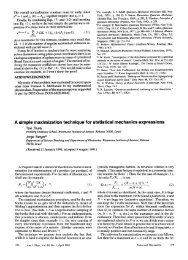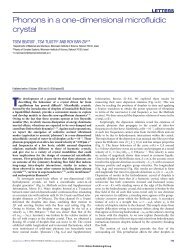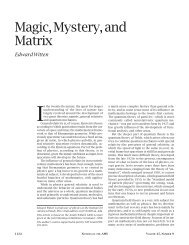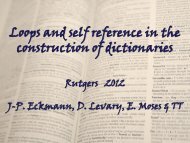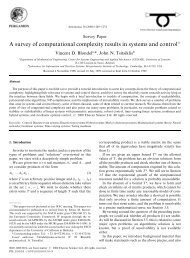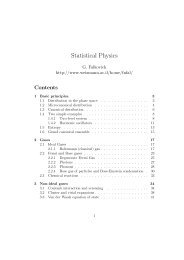Eternal inflation and its implications
Eternal inflation and its implications
Eternal inflation and its implications
Create successful ePaper yourself
Turn your PDF publications into a flip-book with our unique Google optimized e-Paper software.
<strong>Eternal</strong> <strong>inflation</strong> <strong>and</strong> <strong>its</strong> <strong>implications</strong> 16<br />
It is difficult to apply this theorem to general <strong>inflation</strong>ary models, since there is no<br />
accepted definition of what exactly defines this class. However, in st<strong>and</strong>ard eternally<br />
inflating models, the future of any point in the inflating region can be described by a<br />
stochastic model [48] for inflaton evolution, valid until the end of <strong>inflation</strong>. Except for<br />
extremely rare large quantum fluctuations, H > ∼<br />
√<br />
(8π/3)Gρf , where ρ f is the energy<br />
density of the false vacuum driving the <strong>inflation</strong>. The past for an arbitrary model is less<br />
certain, but we consider eternal models for which the past is like the future. In that<br />
case H would be positive almost everywhere in the past inflating region. If, however,<br />
H av > 0 when averaged over a past-directed geodesic, our theorem implies that the<br />
geodesic is incomplete.<br />
There is of course no conclusion that an eternally inflating model must have a<br />
unique beginning, <strong>and</strong> no conclusion that there is an upper bound on the length of<br />
all backwards-going geodesics from a given point. There may be models with regions<br />
of contraction embedded within the exp<strong>and</strong>ing region that could evade our theorem.<br />
Aguirre <strong>and</strong> [49, 50] have proposed a model that evades our theorem, in which the<br />
arrow of time reverses at the t = −∞ hypersurface, so the universe “exp<strong>and</strong>s” in both<br />
halves of the full de Sitter space.<br />
The theorem does show, however, that an eternally inflating model of the type<br />
usually assumed, which would lead to H av > 0 for past-directed geodesics, cannot<br />
be complete. Some new physics (i.e., not <strong>inflation</strong>) would be needed to describe the<br />
past boundary of the inflating region. One possibility would be some kind of quantum<br />
creation event.<br />
One particular application of the theory is the cyclic ekpyrotic model of Steinhardt<br />
& Turok [51]. This model has H av > 0 for null geodesics for a single cycle, <strong>and</strong> since<br />
every cycle is identical, H av > 0 when averaged over all cycles. The cyclic model is<br />
therefore past-incomplete, <strong>and</strong> requires a boundary condition in the past.<br />
7. Conclusion<br />
In this paper I have summarized the arguments that strongly suggest that our universe<br />
is the product of <strong>inflation</strong>. I argued that <strong>inflation</strong> can explain the size, the Hubble<br />
expansion, the homogeneity, the isotropy, <strong>and</strong> the flatness of our universe, as well as<br />
the absence of magnetic monopoles, <strong>and</strong> even the characteristics of the nonuniformities.<br />
The detailed observations of the cosmic background radiation anisotropies continue to<br />
fall in line with <strong>inflation</strong>ary expectations, <strong>and</strong> the evidence for an accelerating universe<br />
f<strong>its</strong> beautifully with the <strong>inflation</strong>ary preference for a flat universe. Our current picture<br />
of the universe seems strange, with 95% of the energy in forms of matter that we do not<br />
underst<strong>and</strong>, but nonetheless the picture f<strong>its</strong> together extraordinarily well.<br />
Next I turned to the question of eternal <strong>inflation</strong>, claiming that essentially all<br />
<strong>inflation</strong>ary models are eternal. In my opinion this makes <strong>inflation</strong> very robust: if it<br />
starts anywhere, at any time in all of eternity, it produces an infinite number of pocket<br />
universes. A crucial issue in our underst<strong>and</strong>ing of fundamental physics is the selection


